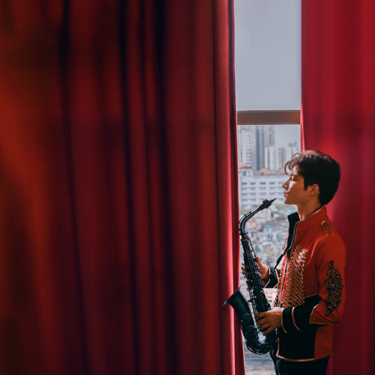Wie sieht ein Traumtag in Montreux aus? Diese Frage stellten wir den Journalisten, die jeden Sommer über die Konzerte und hinter den Kulissen der MJF berichten! Finden Sie ihre Geschichten, vom 3. bis 18. Juli auf unserer Website.
At first, it’s a few distant beats. Then a muffled beat making the walls shake and a binary drum soon joined by layers of keyboard and a slamming bass… “How does it feel, to treat me like you do?” Bernard Sumner casually drops. And the Auditorium Stravinski goes into an ecstatic trance which we intuitively knew would be one of the great moments of the 54th Montreux Jazz. “Blue Monday”, one of the greatest hymns in the history of electro-pop, has finally joined the list of hits which, for more than half a century, have made the Lake Geneva festival the jukebox of twentieth-century music. Released thirty-seven years ago, this New Order classic remains the best-selling 12-inch single in the history of vinyl. We dreamed of hearing it in Montreux, after a botched first encounter.
“Headlining was Robert Plant, who was not yet described as a legend, but was simply the ex-singer of Led Zeppelin – the band would enter the Rock & Roll Hall of Fame two years later.”
New Order had in fact already played at the Strav‘. In 1993, for the opening of the 27th MJF. The evening was 100% British, but also a little bit special as it marked the inauguration of this vast auditorium bearing the scent of Stravinsky’s Rite of Spring. Headlining was Robert Plant, who was not yet described as a legend, but was simply the ex-singer of Led Zeppelin – the band would enter the Rock & Roll Hall of Fame two years later. We remember meeting him in the hallways leading up to the venue, walking quietly, with no bodyguards watching him and no fans harassing him.
Before the curly-locked rocker roared, it was Bernard Sumner, Peter Hook, Stephen Morris, and Gillian Gilbert who made Stravinski history by being the first musicians to perform there. We had high hopes for this concert, given the rarity of stage appearances by New Order, a group that, if it weren’t for a tragedy, might never have existed. Sumner, Hook, Morris: the three Mancunians had started their career with a group emblematic of the post-punk scene. After two albums which were to have a decisive influence on the sound of the eighties, Joy Division would suddenly disappear on the eve of their first American tour when, on 18 May 1980, singer Ian Curtis took his own life. Thus New Order was born.
“He admits to feeling something special, like an imperceptible shiver, at the idea of returning to a festival whose programme reads like an encyclopaedia of jazz and contemporary music.”
Bernard Sumner, who readily cites the famous Led Zeppelin IV as one of his favourite albums, clearly recalls his first visit to Montreux. Agreeing at the last minute to exchange a few words with the press shortly before his entrance on stage, the singer and guitarist now looks more like a retired history teacher than a pop star. Like so many other musicians over the years backstage at the Strav‘, he admits to feeling something special, like an imperceptible shiver, at the idea of returning to a festival whose programme reads like an encyclopaedia of jazz and contemporary music. The meeting is more like a conversation than a formal interview. As he evokes his passion for film scores and Ennio Morricone’s compositions, we tell him of memorable concerts by David Bowie, Neil Young and Nick Cave in the same Stravinski Auditorium he is about to return to.
Ask him to talk about Ian Curtis? It hadn’t even crossed our minds, out of respect. But now, suddenly, as if driven by an indomitable duty to remember, Sumner wants to salute the man he considered more of a poet than a songwriter. A few hours later, after having put a packed audience into a trance with “Blue Monday” and then the hypnotic “Ceremony”, he performs “Transmission” and “Love Will Tear Us Apart” as a musical remembrance. Forty years after their writer’s death, these two tracks recorded by Joy Division still have a rare intensity, a dark and disenchanted lyricism still heralding the more synthetic and rhythmic sound of New Order.
In 1993, the English group played for only 50 minutes in front of a sparse crowd, with many of the guests who came to inaugurate the Strav‘ visibly clinging to their champagne glasses. In 2020, they performed a two-hour concert for the posterity of Montreux Jazz. At last.
Stéphane Gobbo, Le Temps

